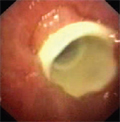The eLitMed.hu medical portal uses computer cookies for convenient operation. Detailed information can be found in the Cookie-policy.
Lege Artis Medicinae - 2007;17(10)
Content
[NEW WAYS IN THE MANAGEMENT OF RHEUMATOID ARTHRITIS IN HUNGARY]
[Rheumatoid arthritis is an autoimmune rheumatic condition of unknown origin. Due to its high prevalence, incompletely solved therapy, significant impact on mortality and morbidity, and the psychological and economic burden it puts on the patient, family and society, rheumatoid arthritis has a major public health significance. Although its importance is still underestimated both by the public and the medical community, today an improving tendency can be observed. The past decade has seen important breakthroughs in terms of increased recognition of the significance of the disease, as well as in its pathogenesis, diagnosis and therapy. The introduction of new diagnostic and prognostic markers and early aggressive treatment, the establishment of early arthritis clinics, and, most importantly, the successful use of biological therapy have revolutionized the management of rheumatoid arthritis. The paper reviews the modern therapy of the disease, touching on the options available in Hungary.]
[RENAL ANAEMIA AND CURRENT ISSUES ON ERYTHROPOIETIN THERAPY]
[Recombinant human erythropoietin has been used for more than 20 years for the treatment of renal anaemia, with epoetin-alfa and -beta representing the common traditional preparations. By the modification of the molecule’s carbohydrate moiety or structure a longer duration of erythropoietin receptor stimulation was achieved. The administration of these new molecules (darbepoetin, C.E.R.A.) once or twice a month is also sufficient to achieve serum haemoglobin target levels, making the treatment safer and more comfortable both for the patients and the personnel. These recently developed synthetic erythropoietin receptor stimulating molecules, along with recombinant human erythropoietin, are together called “Erythropoiesis Stimulating Agents”. In haemodialysed patients the intravenous route is preferred, but the subcutaneous administration can substantially reduce dose requirements. In praedialysed, transplanted or peritoneally dialysed patients, erythropoiesis stimulating agents should preferably be given subcutaneously both for economic and practical reasons. There are ongoing clinical trials with erythropoiesis stimulating molecules that can be administered by inhalation or per os. Current evidence suggests that the serum haemoglobin level should preferably not exceed 12 g/dl with the use of erythropoiesis stimulating agents. No cardiovascular protective effect of higher serum haemoglobin levels was demonstrated in two large clinical trials. Further well-designed studies are necessary to set evidence-based haemoglobin targets for erythropoiesis stimulating treatment. Arguments for a more widespread use of agents with extended duration include medical, financial and patient satisfaction reasons. The release of new erythropoiesis stimulating agents may further simplify the treatment of renal anaemia.]
[Secondary prevention of patients with ischaemic heart disease - The reduction of LDL cholesterol level and the regression of atherosclerosis]
[The authors review the options of secondary medical prevention in patients with ischaemic heart disease, stressing the need and safety of using statins. The beneficial effect of statin therapy on cardiovascular morbidity and mortality and the clinical benefit of the greatest possible reduction in LDL cholesterol level are presented. The atherosclerotic plaque regression achieved by a high-intensity statin therapy in the ASTEROID trial is also briefly reviewed.]
[MOLECULAR DIAGNOSTICS OF EPIDERMAL GROWTH FACTOR RECEPTOR IN NON-SMALL CELL LUNG CANCER]
[One of the most useful markers of non-small cell lung cancer is epidermal growth factor receptor (EGFR) protein expression. Recently it was found that the EGFR gene may be amplified or mutated in non-small cell lung cancer rendering this gene product an ideal target for therapy. The introduction of molecularly targeted therapy into the clinical practice represents a milestone in the management of non-small cell lung cancer. However, our knowledge on the prognostic and predictive factors that will define the efficiency of anti-EGFR therapy is limited. In clinical practice, some common patient and disease features (e. g., smoking habit, gender, histological type) are still more dependable predictors than the fine molecular properties that may directly affect therapeutic response. The indication of anti-EGFR therapy in Hungary is based on the immunohistochemical detection of the EGFR protein, therefore, it is important that these tests are performed as reliably as possible. On the other hand, mutations in the EGFR gene may render the tumour resistant or, in contrary, especially sensitive to EGFR inhibitor therapy. The sequence of the diagnostic steps to define the genotype and phenotype of non-small cell lung cancer has a great importance in terms of cost-efficiency of the therapy.]
[CARCINOMATOUS MENINGITIS]
[INTRODUCTION - Carcinomatous meningitis is a serious complication of advanced stage solid tumours, which may become more common with improved survival. CASE REPORTS - A 53-year-old woman with a recent history of breast cancer (pT2pN2M0) had been treated by mastectomy and adjuvant chemotherapy and radiotherapy. She presented with weakness, diplopia and vertigo raising the possibility of vertebrobasilar ischaemia or an intracranial mass. In another patient, a 62-year-old man with hypertension, a stenotic common bile duct had been diagnosed when examined for abdominal complaints. When he presented with a high blood pressure value accompanied by intensive headache, vomiting and bilateral hearing loss, he was thought to have a hypertensive crisis. The rapidly progressive neurological symptoms and the history of breast cancer and findings suggesting pancreatic head tumour, respectively, led to the clinical diagnosis of carcinomatous meningitis in both cases, despite any evidence on CT scans or a negative MR scan, though of limited value, in the first case. This diagnosis was confirmed by the laboratory and cytological findings of the cerebrospinal fluid, and also by the post mortem examination, since both patients died within a month after the onset of the symptoms. The primary tumour in the second patient proved to be a widely metastasizing diffuse type gastric cancer. CONCLUSION - Carcinomatous meningitis has a varying but characteristic presentation which generally makes it easy to diagnose, but it can sometimes present differential diagnostic problems. What we can learn from these two cases may help in recognizing this complication.]
[INTRAVASCULAR LEIOMYOMATOSIS PRESENTING AS A RIGHT ATRIAL MASS]
[INTRODUCTION - Intravenous leiomyoma is a peculiar, rare tumour that originates from the myomatous uterus, grows into the lumina of veins and, through the inferior vena cava, may extend to the right heart cavity. The intracardial tumour causes severe cardiovascular symptoms and may be fatal. CASE REPORT - The symptoms of the 45-yearold woman consisted of chest discomfort, dizziness, and short periods of unconsciousness, which occurred during vacuum-cleaning when she bent forward. Imaging showed a growth that filled the lumen of the vena cava and extended to the right atrium, swinging between the atrium and ventricle. The patient underwent surgery with cardiopulmonary bypass and the intracardial tumour was removed together with its extensions filling the veins. The histological examination verified intravenous leiomyomatosis. Although the patient refused the recommended hysterectomy, she is well after six years the operation. CONCLUSION - In cases of unspecific cardiac symptoms, the possibility of intravenous leiomyomatosis should be considered. The diagnosis can be set up by echocardiography, MR or CT scan. If the diagnosis is confirmed, the tumour should be surgically removed.]
1.
Clinical Neuroscience
Is there any difference in mortality rates of atrial fibrillation detected before or after ischemic stroke?2.
Clinical Neuroscience
Factors influencing the level of stigma in Parkinson’s disease in western Turkey3.
Clinical Neuroscience
Neuropathic pain and mood disorders in earthquake survivors with peripheral nerve injuries4.
Journal of Nursing Theory and Practice
[Correlations of Sarcopenia, Frailty, Falls and Social Isolation – A Literature Review in the Light of Swedish Statistics]5.
Clinical Neuroscience
[Comparison of pain intensity measurements among patients with low-back pain]1.
Clinical Neuroscience Proceedings
[A Magyar Stroke Társaság XVIII. Kongresszusa és a Magyar Neuroszonológiai Társaság XV. Konferenciája. Absztraktfüzet]2.
3.
Journal of Nursing Theory and Practice
[A selection of the entries submitted to the literary contest "Honorable mission: the joys and challenges of our profession" ]4.
Journal of Nursing Theory and Practice
[End of Life and Palliative Care of Newborns in the Nursing Context]5.
Journal of Nursing Theory and Practice
[Aspects of Occupational Health Nursing for Incurable Patients ]





















